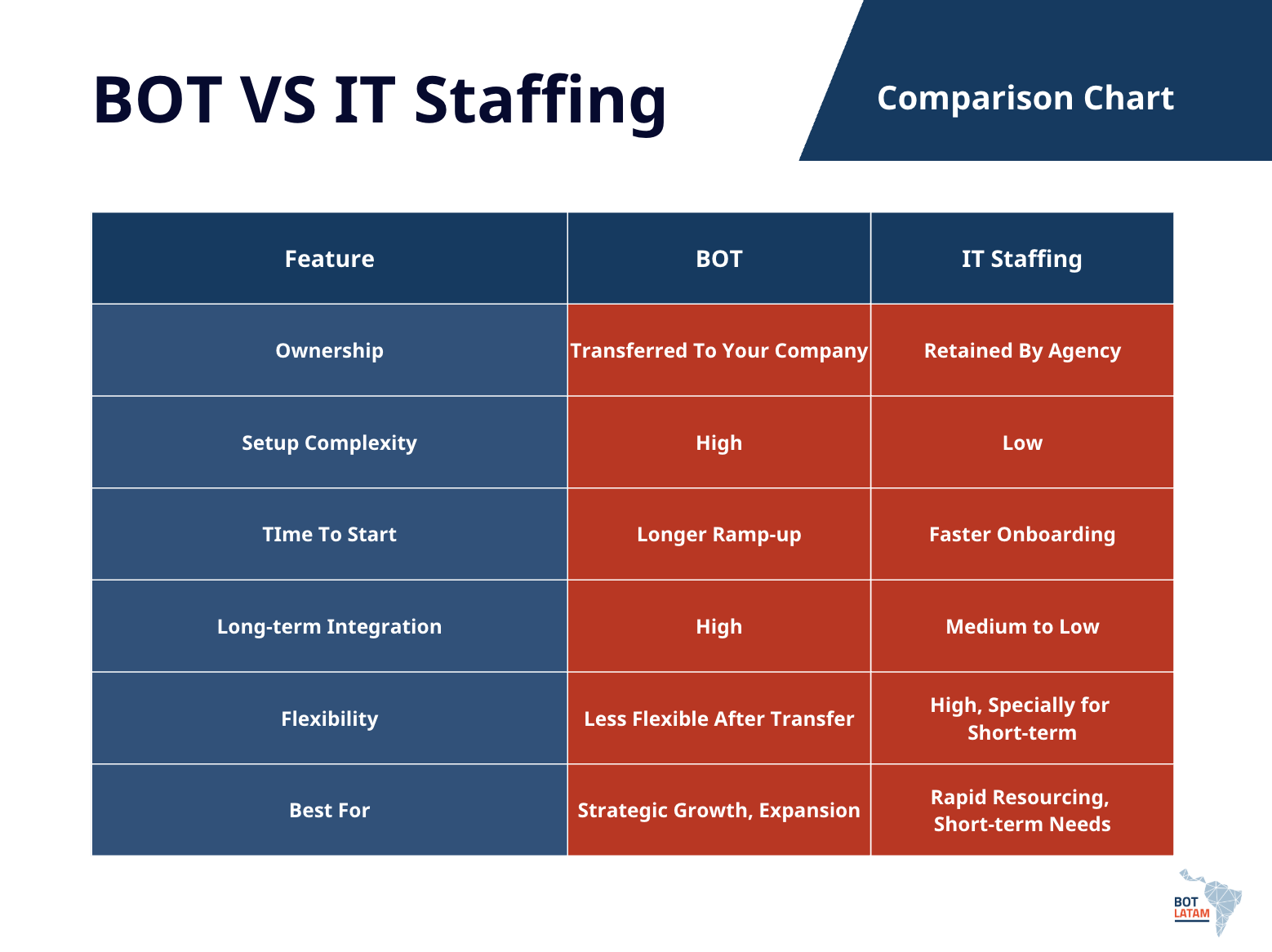Choosing between the Build-Operate-Transfer (BOT) model and an IT staffing agency can feel like comparing apples to oranges, but both can scale your tech team fast. The right option depends on your goals, budget, and how much control you want over your development operations.
This article breaks down the key differences between BOT and IT staffing, compares costs, risks, and long-term impact, and explores real-world use cases. You'll get a clear framework to help decide which model makes sense for your business.
Outsourcing continues to grow, with the global IT services market expected to reach $1.4 trillion by 2027, according to Statista. As demand rises, so does the need to pick the right delivery model, not just a fast one. Let’s dig into what separates BOT from IT staffing and how to choose the model that sets your team up for success. Keep reading to learn more!
Understanding the Difference Between Build-Operate-Transfer and IT Staffing Agencies

What Is the Build-Operate-Transfer (BOT) Model in Tech Development?
The Build-Operate-Transfer model is a structured outsourcing approach. It starts with a third-party partner setting up and running your offshore or nearshore development center. This includes recruiting talent, managing operations, and overseeing delivery. Once the operation is stable and efficient, it’s fully transferred to your ownership. You retain control over intellectual property and long-term team management.
BOT is often used by companies looking to establish a permanent presence in a new region without handling the setup from scratch. It reduces initial risk while allowing for eventual full control. According to Deloitte, BOT models are increasingly popular in LATAM and Eastern Europe due to predictable costs and talent scalability.
How IT Staffing Agencies Work
IT staffing agencies provide pre-vetted tech professionals on a temporary, project-based, or contract-to-hire basis. You get talent fast without long-term commitments. The agency handles sourcing, screening, and sometimes payroll, while you manage the day-to-day work and deliverables.
This model works best when you need to fill roles quickly or when internal hiring is too slow. Gartner reports that over 60% of companies use IT staffing partners to speed up product delivery or backfill key positions during peak demand.
1. Ownership and Control: BOT vs IT Staffing:
With BOT, you eventually own the team, the infrastructure, and the process. It’s like building a remote branch office, but with outsourced help at the start. You make the decisions once the transfer happens.
In contrast, staffing agencies retain control over HR processes and employment terms. You guide the work but don’t own the team. If contractors rotate out frequently, this can lead to less long-term consistency or knowledge retention.
2. Team Integration and Alignment:
BOT teams are built to become a seamless part of your company. Since the end goal is ownership, the operational culture is tailored to mirror your internal processes and values from the start.
While skilled, staffing agency talent typically juggles multiple short-term assignments and may not fully integrate into your workflows. If alignment and team loyalty are priorities, BOT offers stronger long-term cohesion.
3. Strategic vs Tactical Support:
The BOT model is inherently strategic. It’s a long-term investment in geographic expansion, intellectual property protection, and tech team maturity.
On the other hand, IT staffing agencies offer tactical flexibility. You plug in talent when and where it’s needed, but you’re not building infrastructure or operational capabilities in the background.
4. Geographic Impact and Legal Implications:
A BOT setup involves creating entities, legal frameworks, and regulatory compliance in the target country. While the partner manages this early on, these responsibilities eventually transfer to you.
Staffing agencies require no such setup. You’re simply hiring external professionals without any permanent presence in the region. This means fewer legal obligations but also fewer strategic benefits.
Pros and Cons of the Build-Operate-Transfer Model
1. Pro: Long-Term Ownership and Control:
The biggest advantage of the Build-Operate-Transfer model is that the team and infrastructure eventually become yours. This means you gain full control over operations, intellectual property, and internal processes after the transfer. Unlike traditional outsourcing, you’re not locked into a third-party relationship forever. This creates a strong foundation for long-term growth.
2. Pro: Lower Risk Entry Into New Markets
BOT allows you to test new regions, like LATAM or Eastern Europe, without immediately investing in local legal entities or infrastructure. Your partner handles compliance, hiring, and operations during the "operate" phase. According to McKinsey, businesses entering new tech markets through structured partnerships reduce operational risk by up to 40% in the first 18 months.
3. Pro: Stronger Talent Retention and Culture Fit:
Since the team is built with the intention of full transfer, there's usually better alignment with your company culture. Retention rates tend to be higher when compared to standard outsourcing, where developers often cycle through short-term projects. BOT fosters team loyalty and continuity.
4. Pro: Better Alignment With Internal Roadmaps:
BOT setups mirror internal teams more closely than freelance or agency hires. The developers work with your systems, use your tools, and follow your engineering standards. This alignment improves execution on long-term product goals and reduces the friction that often comes with third-party teams.
1. Con: Higher Initial Setup Time and Cost:
The build and operate phases can take 6–18 months, depending on project complexity and location. That’s a longer timeline compared to IT staffing or direct outsourcing. Initial investment in legal setup, talent acquisition, and office infrastructure can also be significant. You need to be prepared for upfront planning and delayed ROI.
2. Con: Legal and Regulatory Complexity:
Eventually, your company assumes all local legal obligations. This includes employment laws, taxes, data protection, and compliance. If you’re expanding into countries with complex labor regulations or limited legal support, the transition can become a bottleneck without the right advisors.
3. Con: Limited Agility After Transfer:
Once the transfer is complete, adjusting the team size or changing direction quickly becomes harder. You now manage a fully owned operation, not a flexible vendor contract. That’s great for stability, but not ideal if your business requires rapid pivots or frequent scope changes.
4. Con: Not Ideal for Short-Term Projects:
If you're solving a short-term resource gap or testing a feature MVP, BOT isn’t the best fit. The model is built for long-term strategic value, not rapid deployment. In these cases, the operational overhead outweighs the benefits.
5. Con: Requires Internal Readiness:
BOT models demand internal bandwidth. You need experienced leadership to oversee the transition, integrate the new team, and manage the post-transfer operation. Without this, there's a risk of misalignment or underperformance once the handover occurs.
Pros and Cons of IT Staffing Agencies
1. Pro: Fast Access to Pre-Vetted Talent:
IT staffing agencies specialize in quickly placing skilled developers, engineers, and project managers. This speed-to-hire is ideal when you're under pressure to fill roles fast. According to TechServe Alliance, the average time-to-fill for IT roles through staffing agencies is 30-40% faster than traditional hiring channels.
2. Pro: Flexible Staffing for Fluctuating Workloads:
You can scale your team up or down as project demands shift. Staffing agencies allow you to hire contractors for weeks or months without long-term commitments. This flexibility is especially useful for companies managing seasonal spikes or short-term product releases.
3. Pro: Lower Administrative Overhead:
Agencies handle payroll, benefits, legal compliance, and in many cases, onboarding. That means fewer internal HR resources are required. You're able to plug talent directly into your workflow without needing to manage employment logistics across different jurisdictions.
4. Pro: Access to Niche Skill Sets:
Many staffing firms maintain pools of specialists with high-demand skills like DevOps, data engineering, or cybersecurity. For roles that are tough to recruit for internally, agencies often provide access to talent you wouldn't easily find on your own.
1. Con: Limited Team Integration:
Most contractors hired through staffing agencies operate outside your core team structure. That can result in lower engagement, weaker communication, and a lack of shared ownership. A Gallup study found that non-permanent workers are 27% less likely to feel connected to a company’s mission or values.
2. Con: Risk of High Turnover:
Temporary staff are more likely to leave for higher-paying contracts or full-time roles elsewhere. This instability can delay projects or increase the cost of re-training replacements. Without long-term incentives, retention can be unpredictable.
3. Con: Less Control Over Hiring Standards:
Even with quality screening, the final selection process is often agency-led. You might have limited visibility into how candidates were vetted or whether they align with your team’s technical and cultural expectations. This can lead to mismatches that take time and resources to correct.
4. Con: Ongoing Costs Without Long-Term Value:
While agencies save time upfront, costs can add up quickly. Hourly markups typically range from 25% to 75%, depending on skill set and region. And since you don’t retain the talent, there's no compounding value over time. It’s a pay-as-you-go model with little residual ROI.
5. Con: Not Ideal for Strategic Roles:
If you're building a product from the ground up or filling leadership gaps, staffing agencies aren’t always the best fit. Contractors can execute tasks efficiently, but they may not have the context, authority, or long-term accountability needed for core strategic initiatives.
Checklist: What fits your business best?
If long-term ownership of your offshore team is important, the Build-Operate-Transfer model likely fits better. It’s built around the idea that, after an initial period of external management, you’ll assume full control of the team, infrastructure, and operations. This is ideal for companies with long-term roadmaps who see their offshore operation as a permanent extension of their core business.
BOT also makes sense if you're planning a multi-year product strategy or entering a new geographic market. It minimizes early legal and operational risk, especially in regions with complex regulatory environments. However, it requires upfront investment and leadership bandwidth to guide the eventual transfer. If your internal team includes experienced managers who can support the integration and oversee the transition, BOT creates a strong foundation for global growth.
On the other hand, IT staffing agencies are often a better fit when speed and flexibility are the top priorities. If you're looking to fill technical roles quickly, especially on a short-term basis, staffing agencies can deliver vetted professionals in a fraction of the time it takes to hire internally. Glassdoor reports that the average hiring time for tech roles exceeds 35 days, while staffing firms often cut that timeline significantly.
Staffing also works well when your projects are temporary or your product roadmap is still evolving. If your business needs to pivot frequently or adjust workloads month-to-month, the low-commitment nature of staffing contracts gives you more agility. It’s especially useful when internal HR resources are limited or when you're exploring new technologies without long-term certainty.
Ultimately, your decision should align with your business objectives. If you’re planning to scale strategically, retain intellectual property, and build a dedicated team, BOT is a stronger fit. But if you need to stay lean, move fast, and fill gaps on the fly, an IT staffing agency will offer the flexibility you need without long-term obligations. Matching the model to your stage of growth, not just to cost, delivers better outcomes.
Ready to Hire Developers in Latin America?
Choosing between Build-Operate-Transfer and IT staffing isn’t just about cost, it’s about long-term control, risk tolerance, and how fast you need to scale. Each model comes with clear trade-offs, and the right decision depends on how your business plans to grow and where it needs operational leverage.
At BOT LATAM, we help companies apply the BOT model in Latin America through fully managed BOT partnerships. Our model is designed for organizations that want more than just temporary support, they want ownership, operational continuity, and regional expertise. With over a decade of experience launching and transferring high-performance teams across LATAM, we provide the legal, operational, and talent infrastructure to help you expand with confidence.
If you're weighing BOT vs IT staffing for your next move, we can help you assess the path that fits your growth goals, backed by real data, transparent planning, and local execution. Contact us to schedule a free outsourcing strategy call and get this decision right!

Revolutionize Your Workflow with Our Innovative BOT Strategy!
Enhance your operations seamlessly and adapt to market demands
Contact Us

.jpg)


%2017.26.38.png)